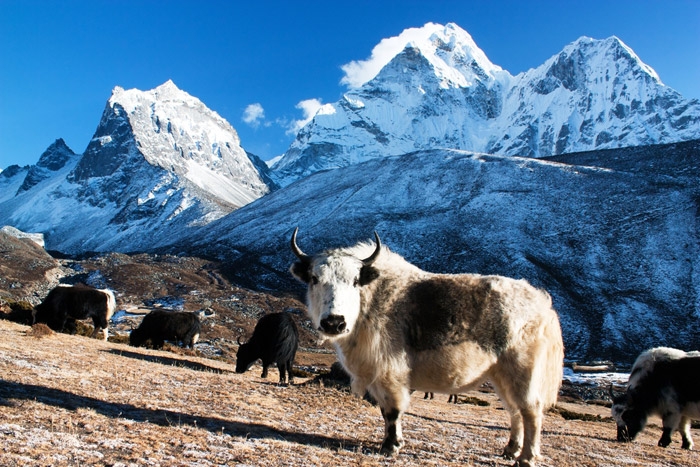
Todays post will be focused on UNESCO World Heritage Sites. A World Heritage Site is a place that is selected by UNESCO because it holds special cultural or physical significance. These sites are expected to maintain authenticity and bring on education of ancient culture to travelers. There are 5 characteristics common among UNESCO sites: They collaborate, find the fit between the community and tourism, make sites and programs come alive, focus on authenticity and quality, and they preserve and protect resources. 962 listed properties are listed on the UNESCO World Heritage List, but 39 of these sites are given the distinction of being “In Danger” because they do not follow all of the characteristics. In todays post I want to highlight two UNESCO World Heritage Sites: Cultural Landscapes and Archeological Remains of the Bamiyan Valley from the in danger list, and the Sagarmatha National Park in Nepal from the regular list.
Cultural Landscapes and Archeological Remains of the Bamiyan Valley was selected by UNESCO in 2003 because of its representation of the cultural, religious, and artistic developments of the Ancient Bakhtria. Many religiously influenced archeological remains are present in the Valley. The most prominent religious influence is from Buddhism, which spilled over from India with the emergence of the Silk Road. The most famous remains at the side were two giant Buda’s (55m and 38m) tall that were carved into the sandstone cliffs. Unfortunately, the Taliban tragically destroyed these magnificent sculptures in 2001. This site is unique in terms of UNESCO classification because it was listed as a World Heritage Site in Danger at the same time it was listed as a World Heritage Site. The primary reason for its “in danger” classification is safety concerns over undetonated landmines and a lack of conservation effort from those in the area. One characteristic this site is violating is collaboration because in 2003 the area was void of any efforts to unite people in preserving the archeological remains. Another characteristic that UNESCO worried it would violate was protection of natural resources. But with careful demining projects that work to limit damage on the land and a new focus on conservation, UNESCO is close to taking off the “in danger” classification it initially given.
Sagaramatha National Park in Nepal is an exemplary example of a site worthy of its UNESCO World Heritage tittle. The park features striking beauty from high mountains, glaciers, and Sherpa culture. The park is home to the worlds highest mountain Mt Sagarmatha (Everest), as well as seven other peaks above 8,000 meters tall. This park was recognized by UNESCO because of its careful preservation of it geology. The park takes steps to limit visitors to the area, educate visitors on Sherpa culture, and have place restrictions on hunting due to the endangered species in the area. Other areas of Nepal need to follow the example the park has set for establishing a sustainable tourism environment.
Cultural Landscapes and Archeological Remains of the Bamiyan Valley was selected by UNESCO in 2003 because of its representation of the cultural, religious, and artistic developments of the Ancient Bakhtria. Many religiously influenced archeological remains are present in the Valley. The most prominent religious influence is from Buddhism, which spilled over from India with the emergence of the Silk Road. The most famous remains at the side were two giant Buda’s (55m and 38m) tall that were carved into the sandstone cliffs. Unfortunately, the Taliban tragically destroyed these magnificent sculptures in 2001. This site is unique in terms of UNESCO classification because it was listed as a World Heritage Site in Danger at the same time it was listed as a World Heritage Site. The primary reason for its “in danger” classification is safety concerns over undetonated landmines and a lack of conservation effort from those in the area. One characteristic this site is violating is collaboration because in 2003 the area was void of any efforts to unite people in preserving the archeological remains. Another characteristic that UNESCO worried it would violate was protection of natural resources. But with careful demining projects that work to limit damage on the land and a new focus on conservation, UNESCO is close to taking off the “in danger” classification it initially given.
Sagaramatha National Park in Nepal is an exemplary example of a site worthy of its UNESCO World Heritage tittle. The park features striking beauty from high mountains, glaciers, and Sherpa culture. The park is home to the worlds highest mountain Mt Sagarmatha (Everest), as well as seven other peaks above 8,000 meters tall. This park was recognized by UNESCO because of its careful preservation of it geology. The park takes steps to limit visitors to the area, educate visitors on Sherpa culture, and have place restrictions on hunting due to the endangered species in the area. Other areas of Nepal need to follow the example the park has set for establishing a sustainable tourism environment.

 RSS Feed
RSS Feed